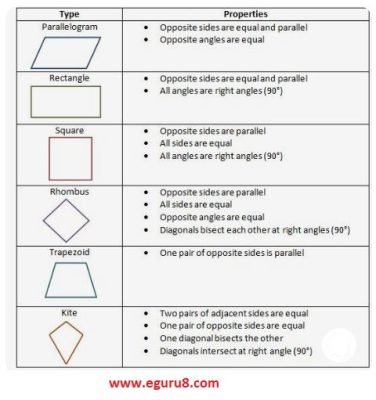NCERT Solutions of Class 8 Maths Chapter 3 Understanding Quadrilaterals Exercise 3.4
Introduction :
In the chapter Understanding Quadrilaterals you will come to know about the some special parallelograms like rhombus, square and rectangle.
Rhombus: Rhombus is a quadrilateral with sides of equal length. The most useful property of rhombus is that the diagonals of a rhombus are perpendicular bisectors of one another.
Rectangle: A rectangle is a parallelogram with equal angles. Being a parallelogram, the rectangle has opposite sides of equal length and its diagonal bisect each other.
Square: A square is a rectangle with equal sides. A square has all the properties of a rectangle with an additional requirement that all the sides have equal length. The diagonals of a square are perpendicular bisectors of each other.

- Class 8 Maths Understanding Quadrilaterals Exercise 3.1
- Class 8 Maths Understanding Quadrilaterals Exercise 3.2
- Class 8 Maths Understanding Quadrilaterals Exercise 3.3
- Class 8 Maths Understanding Quadrilaterals Exercise 3.4
NCERT Solutions of Class 8 Maths Chapter 3 Understanding Quadrilaterals Exercise 3.4
Q1.State whether True or False.
(a) All rectangles are squares.
(b) All rhombuses are parallelograms.
(c) All squares are rhombuses and also rectangles.
(d) All squares are not parallelograms.
(e) All kites are rhombuses.
(f) All rhombuses are kites.
(g) All parallelograms are trapeziums.
(h) All squares are trapeziums.
Solution:
a) False
b) True
c) True
d) False
e) False
f) True
g) True
h) True
Class 8 Maths Chapter 3 of Quadrilaterals
Q2. Identify all the quadrilaterals that have
(a) four sides of equal length
(b) four right angles
Solution:
a) Rhombus and Square
b) Rectangle and Square
Q3.Explain how a square is
(i) a quadrilateral
(ii) a parallelogram
(iii) a rhombus
(iv) a rectangle
Solution:
i) A square is a quadrilateral because it has four sides.
ii) A square is a parallelogram because it's opposite sides are equal and parallel; its opposite angles are equal.
iii) A square is a rhombus because its all sides are equal.
iv) A square is a rectangle because its opposite sides are equal and it has equal diagonal.
Q4. Name the quadrilaterals whose diagonals
(i) bisect each other
(ii) are perpendicular bisectors of each other
(iii) are equal
Solution:
(i) Parallelogram, rectangle, square and rhombus
(ii) Square and rhombus
(iii) Rectangle and square
Q5. Explain why a rectangle is a convex quadrilateral ?
Solution: A rectangle is a convex quadrilateral because both of its diagonals lie in its interior.
Q6. ABC is a right-angled triangle and O is the midpoint of the side opposite to the right angle. Explain why O is equidistant from A, B and C. (The dotted lines are drawn additionally to help you).

Solution: From the above figure we can observe that it is a rectangle and in rectangle, diagonals of equal length bisect each other , therefore OA=OB=OC= OD.
That is why O is equidistant from A,B and C.
- Class 8 Maths Understanding Quadrilaterals Exercise 3.1
- Class 8 Maths Understanding Quadrilaterals Exercise 3.2
- Class 8 Maths Understanding Quadrilaterals Exercise 3.3
- Class 8 Maths Understanding Quadrilaterals Exercise 3.4